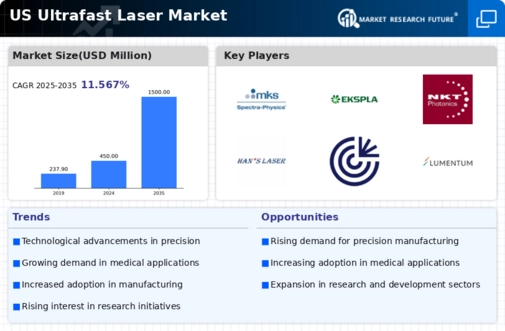Increased Focus on Material Processing
The ultrafast laser market is witnessing growth due to an increased focus on material processing applications. Industries such as automotive, aerospace, and electronics are adopting ultrafast lasers for their ability to process a wide range of materials with high precision and minimal thermal damage. This capability is particularly valuable in applications like cutting, drilling, and surface structuring. The market for material processing is expected to grow at a CAGR of over 10% in the coming years, indicating a robust demand for ultrafast laser technology. As industries seek to enhance product quality and reduce waste, the ultrafast laser market is likely to see sustained growth driven by these material processing needs.
Expansion of Semiconductor Manufacturing
The ultrafast laser market is benefiting from the expansion of the semiconductor manufacturing sector. As the demand for smaller, more efficient electronic devices grows, manufacturers are increasingly turning to ultrafast lasers for precision micromachining and wafer processing. These lasers enable the production of intricate patterns and structures on semiconductor materials, which is essential for the development of advanced microchips. The semiconductor industry in the US is projected to reach $500 billion by 2026, with ultrafast lasers playing a pivotal role in enhancing production capabilities. This growth is likely to drive further investments in ultrafast laser technology, thereby propelling the market forward.
Rising Demand in Research and Development
The ultrafast laser market is significantly influenced by the increasing demand for advanced research and development across various scientific fields. Institutions and laboratories are investing heavily in ultrafast laser technology to facilitate groundbreaking research in areas such as material science, biology, and physics. The ability of ultrafast lasers to produce extremely short pulses of light allows researchers to observe and manipulate processes at the molecular level, which is crucial for innovation. In the US, funding for scientific research has seen a steady increase, with federal and private investments contributing to the growth of the ultrafast laser market. This trend is expected to continue, as the need for precision and efficiency in research drives further adoption of ultrafast laser systems.
Technological Advancements in Laser Systems
The ultrafast laser market is experiencing a surge due to rapid technological advancements in laser systems. Innovations in laser design and materials have led to improved performance and efficiency. For instance, the development of fiber lasers and solid-state lasers has enhanced the capabilities of ultrafast lasers, making them more versatile for various applications. The market is projected to reach approximately $1.5 billion by 2026, driven by these advancements. Furthermore, the integration of artificial intelligence in laser systems is expected to optimize their functionality, thereby expanding their use in sectors such as manufacturing and telecommunications. As these technologies evolve, they are likely to create new opportunities within the ultrafast laser market, attracting investments and fostering growth.
Growing Interest in Photonics and Optoelectronics
The ultrafast laser market is being propelled by the growing interest in photonics and optoelectronics. As these fields advance, the demand for ultrafast lasers, which are essential for various applications such as telecommunications, imaging, and sensing, is increasing. The integration of ultrafast lasers in optoelectronic devices enhances their performance and efficiency, making them more attractive to manufacturers. The US photonics market is projected to exceed $1 trillion by 2026, with ultrafast lasers playing a crucial role in this growth. This trend suggests that as the photonics industry expands, the ultrafast laser market will likely benefit from increased adoption and innovation.





















Leave a Comment